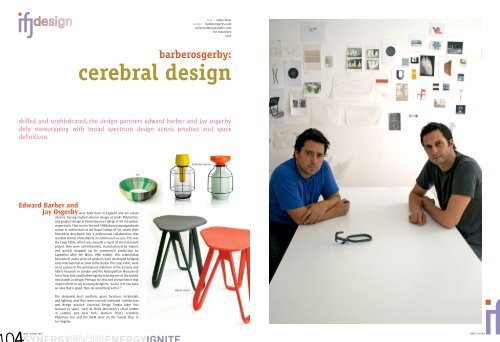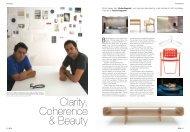cerebral design - Barber Osgerby
cerebral design - Barber Osgerby
cerebral design - Barber Osgerby
Create successful ePaper yourself
Turn your PDF publications into a flip-book with our unique Google optimized e-Paper software.
<strong>design</strong><br />
text : : sylvia khan<br />
visuals : : barberosgerby.com<br />
universal<strong>design</strong>studio.com<br />
lee mawdsley<br />
sony<br />
barberosgerby:<br />
<strong>cerebral</strong> <strong>design</strong><br />
skilled and sophisticated, the <strong>design</strong> partners edward barber and jay osgerby<br />
defy stereotyping with broad spectrum <strong>design</strong> across product and space<br />
definitions<br />
Edward <strong>Barber</strong> and<br />
Jay <strong>Osgerby</strong><br />
were both born in England and are urban<br />
citizens, having studied interior <strong>design</strong> at Leeds Polytechnic<br />
and product <strong>design</strong> at Ravensbourne College of Art in London,<br />
respectively. They met in the mid-1990s during a postgraduate<br />
course in architecture at the Royal College of Art, where their<br />
friendship developed into a professional collaboration that<br />
resulted almost immediately in commercial success. This was<br />
the Loop Table, which was actually a reject of the restaurant<br />
project they were commissioned, manufactured by Isokon,<br />
and quickly snapped up for commercial production by<br />
Cappellini after the Milan 1996 exhibit. This relationship<br />
blossomed, and a series of products were developed bringing<br />
early international acclaim to the studio. The Loop Table, went<br />
on to a place in the permanent collection of the Victoria and<br />
Albert Museum in London and the Metropolitan Museum of<br />
Art in New York and <strong>Barber</strong><strong>Osgerby</strong> to being one of the hottest<br />
new names in <strong>design</strong>. Perhaps it is this sort of experience that<br />
inspires them to say to young <strong>design</strong>ers, “Go for it! If you have<br />
an idea that is good, then do something with it !”<br />
The <strong>design</strong>ing duo’s portfolio spans furniture, incidentals<br />
and lighting, and their more recently instituted architecture<br />
and <strong>design</strong> practice Universal Design Studio takes this<br />
forward to space, such as Stella McCartney’s retail outlets<br />
in London and New York; Damien Hirst’s erstwhile<br />
Pharmacy bar and the H&M store on the Sunset Strip in<br />
Los Angeles.<br />
iris<br />
saturn stools<br />
lanterne marine<br />
JULY - AUGUST 2010 IGNITE | DESIGN
Combining the sensitive and the <strong>cerebral</strong>, the<br />
work of <strong>Barber</strong><strong>Osgerby</strong> may be seen in important<br />
centers such as the De La Warr Pavilion, a<br />
landmarked Modernist arts center, where they<br />
were commissioned to <strong>design</strong> furniture for outdoor<br />
and indoor use, that replaced the original Alvar<br />
Aalto <strong>design</strong>ed pieces. They show a rare degree<br />
of practicality, using materials and technology<br />
with care, fearing useless and expensive<br />
showpieces with little use, and preferring instead<br />
to create objects that people will use, and cherish,<br />
over time.<br />
They’ve done several commissioned pieces for<br />
companies like big boys Established & Sons (see<br />
IFJ vol:06, issue :06, 2009), Magis, Cappellini and<br />
Flos, but also for brands like Coca Cola, Levi’s,<br />
Pantone, Swarovski and Sony. . Royal Institute of<br />
British Architects and the St. Thomas Cathedral in<br />
Portsmouth, England, and sculptural pieces for<br />
public spaces including Greenwich Park.<br />
<strong>Barber</strong><strong>Osgerby</strong>’s <strong>design</strong>s can be found in the<br />
permanent collections of the Victoria & Albert<br />
Museum in London, the Art Institute of Chicago,<br />
and the Metropolitan Museum of Art in New York<br />
Their exhibit space for Sony at the Milan<br />
Design Week, 2010, pushed out frontiers in a<br />
uniquely adventurous way. The exhibit called<br />
“Contemplating Monolithic Design” explores<br />
the integration of electronics with furniture and<br />
architectural <strong>design</strong>, offering visitors a conceptual<br />
glimpse of how living rooms of the future could<br />
possibly look, and was based in an anechoic<br />
chamber; filled with sound absorbing cones to<br />
create a noiseless space.<br />
Speaking of this space, Edward <strong>Barber</strong> and Jay<br />
<strong>Osgerby</strong> said, “Our thinking was to create abstract<br />
objects for the everyday living environment, to<br />
show suggestions of how the Sony technologies<br />
might appear in our lives. We found it most<br />
interesting to explore abstracted, pure forms,<br />
each one representing a different area of the<br />
living space. We have used simple raw materials,<br />
since these seemed a strong partner for the great<br />
complexity of the micro-technology that they<br />
were paired with.” IFJ had the pleasure of catching the <strong>design</strong>ers in an<br />
informal Q n A . . .<br />
alu shell chair<br />
JULY - AUGUST 2010<br />
riba desk<br />
birds on a wire<br />
<strong>Barber</strong><strong>Osgerby</strong><br />
IFJ : Is there something you could point to as an “early influence” . . . something that could have<br />
inspired you to choose <strong>design</strong>, over say, engineering or hairdressing ?<br />
B-O : We have always been greatly inspired by functional, crafted objects created for performance in<br />
nautical and aeronautical engineering. And growing up, these are the things that fascinated us – boats<br />
and aeroplanes. There was no ‘eureka’ moment for us, we have always liked working with our hands<br />
making things, drawing, and solving problems so it was a natural progression.<br />
IFJ : There are some <strong>design</strong>ers who one almost ‘slots’ in one’s mind as “the furniture guys” or the<br />
“lighting guys” . . . this wasn’t possible with your work . . What sort of work really excites you ? Do you<br />
have a favourite thing to do ?<br />
B-O : It is true that lots of areas are exciting to us. We find in particular that the challenge of working to<br />
a tight brief is actually really exciting and produces amazing results.<br />
IFJ : The great thing about doing your job in the 21st century is you have this amazing palette of<br />
“playthings” . . . technology offers you material and new ways in which to treat it. How has this<br />
affected your offerings ?<br />
B-O : We still work by hand, sketching and making full scale 3D models of every <strong>design</strong> in foam or card,<br />
otherwise there is no way to really test the results - when you make models from a sketch they often<br />
develop quite different personalities to the initial ideas we intended. We now only finish a <strong>design</strong> on the<br />
computer.<br />
IFJ : Some <strong>design</strong>ers seem to prefer a particular material<br />
over the others . . . is yours aluminium ? Is there something<br />
intrinsic in aluminium as a material, that you find particularly<br />
interesting ?<br />
B-O : Aluminium has definitely been a theme with products such<br />
as Iris, Shell and Zero-in, but our original core material was<br />
plywood (Loop). We still make models in white card, a material<br />
that we have used since our architectural studies. Aluminium is<br />
great in this sense [environmental responsibility] as it can easily<br />
be recycled by simply melting it down and reusing it.<br />
RAPID RORSCHAK<br />
poppins<br />
EDWARD BARBER JAY OSGERBY<br />
If I weren’t a <strong>design</strong>er I’d be. . . .<br />
A boat-builder A sculptor<br />
My favourite place to be creative. . .<br />
Looking at the sea Wherever the idea comes.<br />
Lazing on the beach. . . or walking through the woods ?<br />
Walking on the beach The woods<br />
All children must be taught. . . .<br />
To respect others To be kind<br />
blue table<br />
sony milan 2010<br />
IFJ : How would you say you do your bit for the<br />
environment or sustainability ? Does this depend<br />
just on you / your decisions, or do other people<br />
have a bit to do with this ?<br />
B-O : Of course, we are always of aware of the<br />
environmental impact of our work, especially<br />
with temporary installations such as the Sony<br />
exhibition. We actually recycled the foam used to<br />
build the show for Sony by sending it to Sheffield<br />
University so that they could build their own<br />
anechoic chambers.<br />
IFJ : The Sony 2010 Project at the Salone was<br />
something completely out of the expected. How<br />
did you actualize the concept?<br />
B-O : Sony approached us because they loved our<br />
work at <strong>Barber</strong><strong>Osgerby</strong> and wanted to work with<br />
us somehow during the Milan Salone. So together<br />
we built what turned out to be a really unique,<br />
experiential installation. It was also a chance<br />
for us to work together with our architectural<br />
company Universal Design Studio. We also got to<br />
go behind the scenes at the Sony research labs and<br />
glimpse new sound technologies in development<br />
which provided the inspiration for the basis of<br />
our prototype <strong>design</strong>s that were on show. This<br />
really paid off as over 10,000 visitors came to the<br />
exhibition which is three times more than anyone<br />
had forecast.<br />
IFJ : You are both highly trained and skilled at<br />
your craft . . . how has the fact of having a formal<br />
education affected your work, your thinking ?<br />
and how important do you think it is to have that<br />
structured and formal education ?<br />
B-O : We met whilst studying architecture at<br />
the Royal College of Art, however what really<br />
inspires us was working with clients rather than<br />
studying, so we quickly set up a studio together. Of<br />
course, our education provided the basis for our<br />
practice and without it Universal Design Studio,<br />
our architectural practice, would not exist, but<br />
by far the best education, we think, is through<br />
experience.<br />
IFJ : If you could <strong>design</strong> absolutely anything . . .<br />
cost apart . . . what would it be ?<br />
<strong>Barber</strong> : A boat<br />
<strong>Osgerby</strong> : A bridge<br />
IGNITE | DESIGN




